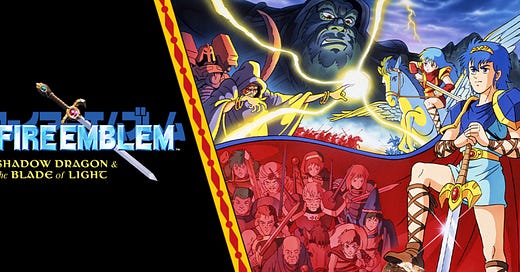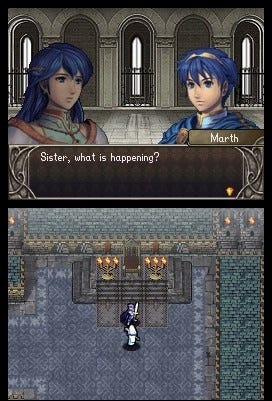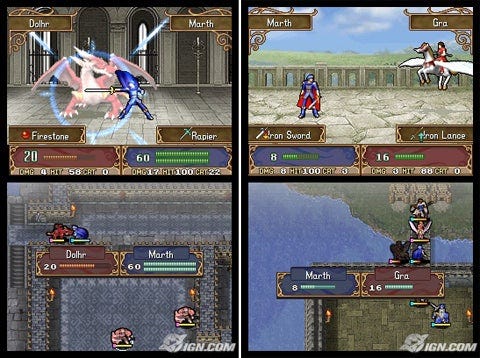Re-release this: Fire Emblem: Shadow Dragon & the Blade of Light
The very first Fire Emblem feels its age in a number of ways, but it also comes with a more modern update.
This column is “Re-release this,” which will focus on games that aren’t easily available, or even available at all, but should be once again. Previous entries in this series can be found through this link.
In many ways, you can easily tell that the first Fire Emblem game belongs to that franchise just by playing it for a few minutes. You’re still controlling various characters in various classes around a map, a few spaces at a time on the grid superimposed over whatever the stage is. There are still experience points and leveling up, while death was permanent from the series’ start. Other than that, however, so much has changed in the now 30-plus years since Shadow Dragon & the Blade of Light released for Nintendo’s Famicom in Japan, and much of it becomes obvious just as quickly as the similarities surface.
The game is a little more serious at all times, due to both the storage restrictions of the Famicom’s cartridges that left only so much room for banter combined with the generally more somber and high fantasy-tone of the writing of series’ creator Shouzou Kaga. The weapon triangle (an expanded rock-paper-scissors scenario for weapon types that works both for and against your units) did not exist yet, and wouldn’t for a few more games. There is no support system in place, no social elements, just battles, battles, and more battles. There is conversation between characters as you recruit them, and the story isn’t all contained within the game’s instruction manual by any means, but it does just, comparatively, wind itself up and go in one direction in a way subsequent Fire Emblems would not.
It’s not even just a matter of old vs. new, or Kaga vs. post-Kaga, either. Genealogy of the Holy War is Fire Emblem 4, written and directed by Kaga just six years after Shadow Dragon & the Blade of Light, and that game is loaded with fascinating story, with conversation between your units, with true narrative highs and lows for the characters, plenty of personality both in the script and within the character roster, as well as nascent social and support elements that would continue to expand as the series aged and grew. At the start for Fire Emblem, though, there was simply the battles, and a game that, while plenty impressive for the time during the genre’s early evolutions, ended up with a remake and expansion on new hardware just four years later for a reason.
That’s pretty standard for the time, really. The Legend of Zelda: A Link to the Past, or Super Metroid, or Kirby Super Star — those are all SNES sequels to classic NES titles that took a very similar approach to their predecessors in a number of ways, but blew their pasts out of the water with improvements and new ideas on top of those foundations. Fire Emblem: Mystery of the Emblem is just another example of this, though in a way more honest than the (non-Super Star) others since it included the original game within, only bigger and better and more refined.
We’re here to talk about Shadow Dragon(s), though, not Mystery of the Emblem, so it’s enough for now to know that the Super Famicom received a game that was both a remake and a sequel to the first-ever Fire Emblem title, and that it’s never been officially released outside of Japan. Shadow Dragon & the Blade of Light briefly received a North American release in late-2020 to celebrate Fire Emblem’s 30th anniversary, but has since been removed from the Switch eShop. For reasons. Digital scarcity: it stinks!
The good news, if you missed out on that and would like to experience the original Fire Emblem yourself, is that a completed unofficial translation patch has existed for the Famicom ROM since last summer: if you must see original Marth in the original version of his adventure, there are ways to do so despite Nintendo’s insistence that you don’t have to bother with that outside of a tiny release window. I won’t discourage you from doing so, either, because I absolutely understand the “I just gotta know” mentality. Know first, though, that in comparison to the Fire Emblem titles you’re more familiar with, Shadow Dragon & the Blade of Light is a slog. It’s not bad, so much as it’s the first go at the genre and concept all the way back in 1990, and feels like it.
It’s slower than modern Fire Emblems even when running in its faster settings and without combat animations enabled. Everything just takes a little longer to do, and is less refined in the doing of it, on top of the fact there is simply less going on. The lack of a weapon triangle might have worked out in Fire Emblem Gaiden — the Famicom game that would eventually become Shadows of Valentia on the 3DS — but that’s because an entirely different risk/reward system was put into place there. The weapon triangle’s absence in Shadow Dragon etc. might not have been felt in 1990, when no one knew any differently, but it’s also pretty clear there’s a reason Intelligent Systems went beyond simply having permadeath as the hook for the series and its combat systems. It’s just another tactical RPG, albeit a more punishing one, without something in place to act as the foundation for the rest of it.
Here’s how Shadow Dragon & the Blade of Light works: you have a number of units of varying classes at your disposal. Some are on foot wielding swords or axes, some are on horseback with lances, some are atop a pegasus and can fly. Without a weapon triangle, the differences are mostly in how far these units can travel, and, in some cases, what their statistics look like. A unit covered head to toe in heavy armor can take more damage than a very lightly armored pegasus rider, while your healers and mages, all dressed in their robes, have more resistance to magic than they do inherent defenses against being stabbed. It feels more like a Shining Force game in terms of how you end up strategizing and deploying your forces in this sense, though, with permadeath’s presence, that feeling only goes so far.
Prince Marth is the central character, and usually the only one who has to live for you to continue on. He’s the one who can visit villages where you might receive new items or even new units for your army, he’s the one who can seize enemy castles when you’ve defeated their guardians, ending the level, and there are plenty of times where he’s the one who needs to speak to a character on the enemy side in order to recruit them to your own. Marth is not alone in this, since Caeda often verbally disarms some men who don’t really want to be on the side of bandits or what have you, and you’ll find that some of your various units know other ones you’ll come to blows with unless you can recruit them first, but he’s still a central figure in the process. There isn’t a whole lot to him here, but boy, does every character on your side love the guy. One of the through lines of Fire Emblem’s writing basically until Ike showed up was just total subservience to the noble lord protagonists by the knights that serve them, so you’re going to get a lot of that sort of thing.
Marth is the last living descendant of a hero that put down the titular Shadow Dragon a century before, meaning he’s the only person out there who can wield the sword that can do so. So the protecting of Marth by basically everyone is understandable in that sense, since the whole world is going to go to shit if he dies. No pressure, kid. There are twists and turns in the story, and it’s enjoyable enough, but the process of revealing it all just isn’t as fun as it is in future Fire Emblem games. One of which is a remake known more simply as Fire Emblem: Shadow Dragon. The eponymous blade of light, Falchion, is still a central focus of the game and its story, but it no longer gets to be in title in this 2009 Nintendo DS remake.
Unlike the Famicom original, Shadow Dragon received a worldwide release. Also unlike the Famicom original, it doesn’t seem as if audiences cared all that much. Shadow Dragon might have arrived on the DS at a time when the world, rather than just Japan, was familiar with Fire Emblem, and on a platform with a massive install base, to boot. It sold just 526,000 copies worldwide, however, compared to 329,000 for the original Famicom release that was restricted to just Japan, on a console with fewer than 20 million sold.
The DS had 33 million units sold just in Japan and 154 million globally: selling just a couple hundred thousand more copies of this version of the game was a massive disappointment for Nintendo, which probably felt that switching back from console to handheld would solve what ailed Fire Emblem’s sales woes. Blazing Blade and Sacred Stones, both Game Boy Advance releases, surpassed 800,000 sales each earlier in the decade and ranked number 1 and 2 in that regard for the franchise, respectively. And despite the small install base, Path of Radiance still managed 536,000 sales on the GameCube. Radiant Dawn failed to outsell the game it was a sequel to despite the Wii having far more consoles sold than its own predecessor, so Fire Emblem development shifted back to handhelds. Shadow Dragon did not cause sales to recover despite a marketing push centered around finally experiencing the story of that guy you know from Super Smash Bros., and so Nintendo decided not to localize the second remake in this duology, New Mystery of the Emblem — it’s still not localized officially, either, so Marth’s quest never actually reached its true conclusion in North America. (Which also robbed us of experiencing the previously Satellaview-exclusive Fire Emblem content found on that Super Famicom add-on, as it was also remade and included in New Mystery of the Emblem. Luckily, this has also been unofficially translated.)
It’s a shame, too, because while Shadow Dragon was a missed opportunity in some ways in terms of how it remade the original, it’s still a massive improvement. It came with a prologue that better explained, in-game, why Marth had fled his home country and left his sister behind. The weapon triangle is in use, you can now see the range of all enemy units at once with the press of a button while still highlighting specific dangers in your path, and everything moves that much more intuitively and swiftly compared to in the Famicom original. It’s nowhere near the best Fire Emblem game out there — some of the personality and levity that had entered Fire Emblem’s writing in the intervening years was missing from Shadow Dragon in a way New Mystery of the Emblem figured out how to make up for a couple of years later — but it’s easily the ideal way to play this specific version of Shadow Dragon all the same.
The bright side of all of this is that Intelligent Systems ended up developing Fire Emblem: Awakening a few years later while working under the belief that it was going to be the final game in the franchise. Since there weren’t going to be any more Fire Emblem games as far as the developers knew, they ended up throwing a ton of ideas at the wall to see what would stick, as there wasn’t going to be another title in the series to use them in. Rather than a swan’s song, Awakening ended up being more like the cry of a phoenix rising from the ashes. It was not only Fire Emblem’s first-ever million-seller, but also the first game in the series to sell over two million copies, a figure that would then be bested by both Fates and Three Houses. Now the franchise is at a point where even a musou spin-off like Three Hopes managed to ship over one million copies in just two months, and a remake released during the dying days of the 3DS like Shadows of Valentia can outsell all but three of the pre-Awakening Fire Emblem games despite it being overshadowed by literally everything happening in the early days of the Switch.
Do we get to this point if Shadow Dragon does just a little bit better sales-wise? Maybe Intelligent Systems doesn't take the same chances with the first 3DS entry for the series if their backs aren’t against the walls, leading them to maybe playing it safe a la the Game Boy Advance cycle of Fire Emblems, when they were mostly trying to figure out how to continue making these games after the departure of the franchise’s creator. The Fire Emblem universe we ended up with is probably worth sticking with, the loss of New Mystery of the Emblem’s localization worth it in the long run if it helped to bring us to a future with Awakening, Fates, Shadows of Valentia, and Three Houses, instead of one where the possibility of another The Binding Blade was even remotely possible.
Regardless of possible alternate futures and outcomes, we know the score when it comes to Shadow Dragon & the Blade of Light. It’s no longer legally available digitally, but it’s also more of a curiosity at this point than anything, so you’re not missing anything from an enjoyment perspective, perhaps. Yet it’s still goofy that you don’t have the option to legally find out for yourself if you want to, or that Nintendo isn’t doing a better job of keeping its own history available for those who want to peruse it. Of course, its superior remake, Shadow Dragon, soon won’t be available anywhere besides the secondary market and emulation scene, either: it’s currently on the Wii U’s Virtual Console for $10, but only until the end of March 2023, and then it’s vanishing into the ether along with the rest of Nintendo’s past that’s stored there. Both of these issues are solvable problems, but considering the source, don’t expect them to be solved anytime soon. Instead, add them to the pile with the rest of the Fire Emblem games that have already vanished from availability, are about to, or haven’t even had the chance to get to that point yet.
This newsletter is free for anyone to read, but if you’d like to support my ability to continue writing, you can become a Patreon supporter.







I still find it confusing that Nintendo has never released FE 3-6 outside of Japan. With how popular the series is now, I would think putting all of the games on the Switch would be obvious, but I guess Nintendo doesn't feel like re-releasing anything past the NES.